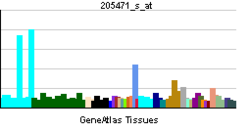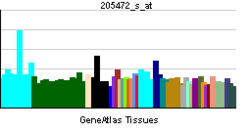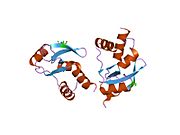- DACH1
-
Dachshund homolog 1 (Drosophila) 
PDB rendering based on 1l8r.Available structures PDB 1l8r Identifiers Symbols DACH1; DACH; FLJ10138 External IDs OMIM: 603803 MGI: 1277991 HomoloGene: 7288 GeneCards: DACH1 Gene Gene Ontology Molecular function • nucleotide binding
• DNA binding
• protein bindingCellular component • nucleus
• nucleolusBiological process • regulation of transcription, DNA-dependent
• multicellular organismal developmentSources: Amigo / QuickGO RNA expression pattern 

More reference expression data Orthologs Species Human Mouse Entrez 1602 13134 Ensembl ENSG00000165659 ENSMUSG00000055639 UniProt Q9UI36 Q9QYB2 RefSeq (mRNA) NM_004392.5 NM_001038610 RefSeq (protein) NP_004383.3 NP_001033699 Location (UCSC) Chr 13:
72.01 – 72.44 MbChr 14:
98.19 – 98.57 MbPubMed search [1] [2] Dachshund homolog 1 (Drosophila), also known as DACH1, is a protein which in humans is encoded by the DACH1 gene.[1][2][3]
Contents
Function
This gene is similar to the D. melanogaster dachshund gene, which encodes a nuclear factor essential for determining cell fates in the eye, leg, and nervous system of the fly. It is a member of the Ski gene family and is thought to be involved in eye development. Four alternatively spliced transcripts encoding different isoforms have been described for this gene.[3]
Interactions
DACH1 has been shown to interact with UBE2I.[4][5]
References
- ^ Hammond KL, Lettice LA, Hill RE, Lee M, Boyle S, Hanson IM (January 1999). "Human (DACH) and mouse (Dach) homologues of Drosophila dachshund map to chromosomes 13q22 and 14E3, respectively". Genomics 55 (2): 252–253. doi:10.1006/geno.1998.5662. PMID 9933575.
- ^ Kozmik Z, Cvekl A (July 1999). "Localization of the human homologue of the Drosophila dachshund gene (DACH) to chromosome 13q21". Genomics 59 (1): 110–111. doi:10.1006/geno.1999.5797. PMID 10395809.
- ^ a b "Entrez Gene: DACH1 dachshund homolog 1 (Drosophila)". http://www.ncbi.nlm.nih.gov/sites/entrez?Db=gene&Cmd=ShowDetailView&TermToSearch=1602.
- ^ Rual, Jean-François; Venkatesan Kavitha, Hao Tong, Hirozane-Kishikawa Tomoko, Dricot Amélie, Li Ning, Berriz Gabriel F, Gibbons Francis D, Dreze Matija, Ayivi-Guedehoussou Nono, Klitgord Niels, Simon Christophe, Boxem Mike, Milstein Stuart, Rosenberg Jennifer, Goldberg Debra S, Zhang Lan V, Wong Sharyl L, Franklin Giovanni, Li Siming, Albala Joanna S, Lim Janghoo, Fraughton Carlene, Llamosas Estelle, Cevik Sebiha, Bex Camille, Lamesch Philippe, Sikorski Robert S, Vandenhaute Jean, Zoghbi Huda Y, Smolyar Alex, Bosak Stephanie, Sequerra Reynaldo, Doucette-Stamm Lynn, Cusick Michael E, Hill David E, Roth Frederick P, Vidal Marc (Oct. 2005). "Towards a proteome-scale map of the human protein-protein interaction network". Nature (England) 437 (7062): 1173–1178. doi:10.1038/nature04209. PMID 16189514.
- ^ Machon, O; Backman M, Julin K, Krauss S (Oct. 2000). "Yeast two-hybrid system identifies the ubiquitin-conjugating enzyme mUbc9 as a potential partner of mouse Dac". Mech. Dev. (IRELAND) 97 (1–2): 3–12. doi:10.1016/S0925-4773(00)00402-0. ISSN 0925-4773. PMID 11025202.
Further reading
- Hammond KL, Hanson IM, Brown AG et al. (2003). "Mammalian and Drosophila dachshund genes are related to the Ski proto-oncogene and are expressed in eye and limb". Mech. Dev. 74 (1–2): 121–131. doi:10.1016/S0925-4773(98)00071-9. PMID 9651501.
- Hammond KL, Lettice LA, Hill RE et al. (1999). "Human (DACH) and mouse (Dach) homologues of Drosophila dachshund map to chromosomes 13q22 and 14E3, respectively". Genomics 55 (2): 252–253. doi:10.1006/geno.1998.5662. PMID 9933575.
- Kozmik Z, Cvekl A (1999). "Localization of the human homologue of the Drosophila dachshund gene (DACH) to chromosome 13q21". Genomics 59 (1): 110–111. doi:10.1006/geno.1999.5797. PMID 10395809.
- Kozmik Z, Pfeffer P, Kralova J et al. (1999). "Molecular cloning and expression of the human and mouse homologues of the Drosophila dachshund gene". Dev. Genes Evol. 209 (9): 537–545. doi:10.1007/s004270050286. PMID 10502110.
- Machon O, Backman M, Julin K, Krauss S (2001). "Yeast two-hybrid system identifies the ubiquitin-conjugating enzyme mUbc9 as a potential partner of mouse Dac". Mech. Dev. 97 (1–2): 3–12. doi:10.1016/S0925-4773(00)00402-0. PMID 11025202.
- Ayres JA, Shum L, Akarsu AN et al. (2001). "DACH: genomic characterization, evaluation as a candidate for postaxial polydactyly type A2, and developmental expression pattern of the mouse homologue". Genomics 77 (1–2): 18–26. doi:10.1006/geno.2001.6618. PMID 11543628.
- Ozaki H, Watanabe Y, Ikeda K, Kawakami K (2002). "Impaired interactions between mouse Eyal harboring mutations found in patients with branchio-oto-renal syndrome and Six, Dach, and G proteins". J. Hum. Genet. 47 (3): 0107–0116. doi:10.1007/s100380200011. PMID 11950062.
- Kim SS, Zhang RG, Braunstein SE et al. (2003). "Structure of the retinal determination protein Dachshund reveals a DNA binding motif". Structure 10 (6): 787–795. doi:10.1016/S0969-2126(02)00769-4. PMID 12057194.
- Ikeda K, Watanabe Y, Ohto H, Kawakami K (2002). "Molecular interaction and synergistic activation of a promoter by Six, Eya, and Dach proteins mediated through CREB binding protein". Mol. Cell. Biol. 22 (19): 6759–6766. doi:10.1128/MCB.22.19.6759-6766.2002. PMC 134036. PMID 12215533. http://www.pubmedcentral.nih.gov/articlerender.fcgi?tool=pmcentrez&artid=134036.
- Strausberg RL, Feingold EA, Grouse LH et al. (2003). "Generation and initial analysis of more than 15,000 full-length human and mouse cDNA sequences". Proc. Natl. Acad. Sci. U.S.A. 99 (26): 16899–16903. doi:10.1073/pnas.242603899. PMC 139241. PMID 12477932. http://www.pubmedcentral.nih.gov/articlerender.fcgi?tool=pmcentrez&artid=139241.
- Wu K, Yang Y, Wang C et al. (2004). "DACH1 inhibits transforming growth factor-beta signaling through binding Smad4". J. Biol. Chem. 278 (51): 51673–51684. doi:10.1074/jbc.M310021200. PMID 14525983.
- Nobrega MA, Ovcharenko I, Afzal V, Rubin EM (2003). "Scanning human gene deserts for long-range enhancers". Science 302 (5644): 413–413. doi:10.1126/science.1088328. PMID 14563999.
- Li X, Oghi KA, Zhang J et al. (2003). "Eya protein phosphatase activity regulates Six1-Dach-Eya transcriptional effects in mammalian organogenesis". Nature 426 (6964): 247–254. doi:10.1038/nature02083. PMID 14628042.
- Ota T, Suzuki Y, Nishikawa T et al. (2004). "Complete sequencing and characterization of 21,243 full-length human cDNAs". Nat. Genet. 36 (1): 40–45. doi:10.1038/ng1285. PMID 14702039.
- Dunham A, Matthews LH, Burton J et al. (2004). "The DNA sequence and analysis of human chromosome 13". Nature 428 (6982): 522–528. doi:10.1038/nature02379. PMC 2665288. PMID 15057823. http://www.pubmedcentral.nih.gov/articlerender.fcgi?tool=pmcentrez&artid=2665288.
- Gerhard DS, Wagner L, Feingold EA et al. (2004). "The status, quality, and expansion of the NIH full-length cDNA project: the Mammalian Gene Collection (MGC)". Genome Res. 14 (10B): 2121–2127. doi:10.1101/gr.2596504. PMC 528928. PMID 15489334. http://www.pubmedcentral.nih.gov/articlerender.fcgi?tool=pmcentrez&artid=528928.
- Martini SR, Davis RL (2005). "The dachshund gene is required for the proper guidance and branching of mushroom body axons in Drosophila melanogaster". J. Neurobiol. 64 (2): 133–144. doi:10.1002/neu.20130. PMID 15818552.
- Rual JF, Venkatesan K, Hao T et al. (2005). "Towards a proteome-scale map of the human protein-protein interaction network". Nature 437 (7062): 1173–1178. doi:10.1038/nature04209. PMID 16189514.
- Wu K, Li A, Rao M et al. (2006). "DACH1 is a cell fate determination factor that inhibits cyclin D1 and breast tumor growth". Mol. Cell. Biol. 26 (19): 7116–7129. doi:10.1128/MCB.00268-06. PMC 1592900. PMID 16980615. http://www.pubmedcentral.nih.gov/articlerender.fcgi?tool=pmcentrez&artid=1592900.
PDB gallery Categories:- Human proteins
- Chromosome 13 gene stubs
Wikimedia Foundation. 2010.

